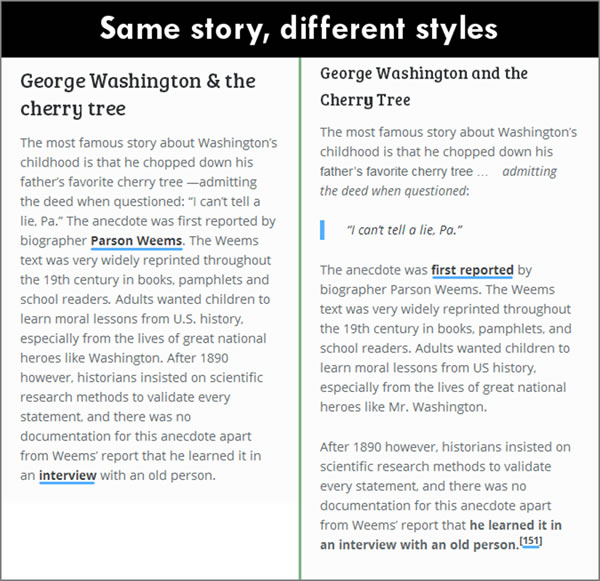How to Align Your Team Around a Consistent Brand Voice

Developing a brand message can be one of the toughest tasks any marketer may face. Communicating that brand message can be even tougher.
Recently, I presented on this very topic to a wonderful group of communications and marketing directors with the top community organizations in my city.
We spent close to an hour discussing the power of a strong brand voice. And the lessons we learned apply to all types of marketing, in all industries.
Why is brand voice important?
If you’ve ever been to Walt Disney World, you’ve witnessed firsthand one of the best examples of perfect alignment around brand voice.
 Every single element of the park has been carefully thought through to ensure that the park is, indeed, the happiest place on earth – from the spotless streets to the smiling park staff.
Every single element of the park has been carefully thought through to ensure that the park is, indeed, the happiest place on earth – from the spotless streets to the smiling park staff.
In fact, Disney even goes so far as to call park staff “cast members,” to remind everyone involved that they are a critical part of the show that goes on every day inside the park.
 Or, raise your hand if you’ve ever been on a Southwest Airlines flight where the flight attendants burst into song? Sure it’s a little cheesy, but it gets you smiling, doesn’t it?
Or, raise your hand if you’ve ever been on a Southwest Airlines flight where the flight attendants burst into song? Sure it’s a little cheesy, but it gets you smiling, doesn’t it?
Of course, that “spontaneous song” actually was planned and rehearsed ahead of time. Those flight attendants had to work together to make that little bit of joy happen.
Brand voice isn’t just a message, tagline or value proposition. It’s the way you present yourself to the world. Is your brand warm and conversational, or formal and professional? Full of slang, to connect with a younger audience, or nostalgic, to attract a senior audience? High-tech? Low-tech?
Consider these two different versions of the same famous story of George Washington and the cherry tree:

If you asked someone on your team to write an article about George Washington, how would they know which approach to take?
It’s critical that you and everyone on your team understand exactly what your brand is and what it isn’t. Let’s walk through how to build this alignment, so you can be sure everyone on your team is moving forward in the same direction.
Know the audience you’re targeting
A fundamental truth in marketing is that YOU don’t matter. The only thing that matters is the audience you’re trying to target:
- What motivates them?
- What do they value?
- How are they alike?
- How are they different?
Consider the screen shot below from the First American Equipment Finance website. This company (and Clariant Creative client) provides equipment leasing services, and they deal primarily with finance executives in large companies.
These executives are used to dealing with bankers and investors. They’re the “suits and ties” of the business world.
Notice what the people in the First American photo are wearing?

However, First American also prides itself on the way it wows these executives with outstanding service. Key to delivering outstanding service is to be accessible and friendly.
That’s why the people in this picture – and in every picture on the First American website – are actual First American employees. First American refuses to use stock photography, preferring instead the authenticity of showcasing their own employees.
In essence, they are saying: We are formal, but we are friendly.
And guess what – it’s working! Read this testimonial on their website:

Boom. Target audience: Nailed. Brand voice: Resonates.
Related Content: Creating Buyer Personas – 22 Interview Questions to Get You Started
Know where you want to go
It’s tough to develop a brand voice if you don’t have a vision for your brand. Let your team weigh in on this vision as you answer some tough questions:
- Who are we today?
- Who do we want to be?
- Who are we definitely not?
- How should be prioritize these goals?
- How should we articulate our vision?
 This brings to mind one of my absolute favorite marketing stories of when Steve Jobs launched the iPod.
This brings to mind one of my absolute favorite marketing stories of when Steve Jobs launched the iPod.
You can imagine that classic moment: Steve on stage in his trademark black turtleneck, salt-and-pepper hair, round glasses. Big screen behind him. Big audience in front of him.
The iPod was going to revolutionize the music industry. But this product was so different, Steve knew that he needed people to “get it,” quickly.
Think about all of the things he could have said about the iPod: the innovative button, the LED display, the colors it comes in, the dimensions of the product, … and the list goes on.
Here’s what he said:
1,000 songs in your pocket.
Mind, blown.
In just five words, everyone in that audience could immediately grasp the enormity of what this tiny little thing could do. The rest, of course, is history.
And Apple is still at it today. Here’s a screen shot of the home page on the Mac website:

Imagine all the things Apple could say about the Mac. But they know exactly where they want to focus. With an incredibly simple headline and a bold graphic, we immediately know that the new Mac is super-fast with an amazing display.
Two things. That’s a whole lot easier to remember than an enormous list of product features and benefits, right?
Related Content: What Is Your Brand Story?
Pulling It All Together
It’s easy at this point to sit back and say, “Well yeah, Apple and Southwest and Disney are big brands with a big voice. We’re not big like they are, and it’s totally different for us.”
No, it’s not.
You just have to know how to pull it all together for your team.
- Paint a clear picture. Know your target audience. Have a vision.
- Keep it simple. Formal but friendly. 1,000 songs in your pocket.
- Repeat yourself often. Trust me, you’re not being redundant; you’re being a leader.
And with that, go forth and speak your voice.
All great content marketing starts with a documented strategy. In fact, only 32% of businesses that don't have a documented strategy feel their content marketing is effective. If you haven't yet formalized your own content strategy, fear not ... our Complete B2B Content Strategy Guide provides guidance and lots of helpful tools to get you started!





